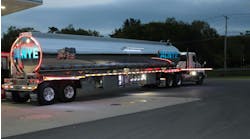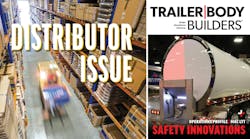Reflecting the impact on dry van demand during the lingering freight recession, Wabash reported net sales for the second quarter of 2024 were down 19.8% year-over-year, to $550.6 million. The company posted consolidated gross profit of $89.7 million, equivalent to 16.3% of sales. Operating income amounted to $43.8 million, representing 7.9% of sales for the quarter.
Wabash President and CEO Brent Yeagy emphasized that a strategic focus on product diversity has enabled Wabash to remain profitable through a “transitional year for the industry” that might have challenged the trailer giant in the past.
“Wabash is not pursuing a single market and we should not be measured in that manner,” Yeagy said on a conference call with investment analysts. “Instead, we are developing a more resilient and diverse array of products and services to serve a dynamic range of customers from first-to-final mile. It's not about doing more of the same. It's about boldly taking the necessary steps to build a foundation of business resilience and growth. This approach will enable us to continue our trajectory of higher highs and higher lows and financial performance.
“Wabash is on track to achieve the best financial performance on record during correction in our industry.”
Total Wabash backlog at the end of the second quarter stood at approximately $1.3 billion, a decrease of 28% compared to the first quarter of 2024 as new order activity slowed, the company reported. While backlog has sequentially declined during the second quarter in each of the last five years, the reduction in 2024 was slightly more than prior years due to continued freight market weakness. Backlog expected to be shipped within the following 12-months amounted to approximately $1 billion.
For the full-year ending, Wabash reduced its revenue outlook to a range of approximately $2.0 billion to $2.2 billion with a midpoint of $2.1 billion.
“With greater information on customers' capital expenditure plans, we feel it's appropriate to reduce our full year guidance," Yeagy said. "As we acknowledge that 2024 will be a down year for the industry, this underscores the importance of the strategic changes we have made at Wabash over the past several years. By streamlining our organization, optimizing our overall customer portfolio, solidifying our balance sheet and narrowing our strategic focus to the transportation, logistics, and distribution markets, we have positioned the company to pursue higher margin and more resilient revenue opportunities.”
Parts stability
As he has on the past several earnings call, Yeagy made the growth opportunities in the parts segment a key point in his presentation.
“Parts and Services is more stable than transportation equipment and as these emerging revenues scale, they will provide a critical stabilizing force within our financial performance,” he said. “But our strategic focus on Parts and Services ultimately ties back to the equipment side of our portfolio. Given the ongoing conditions in freight, it is worth analyzing our portfolio of First-to-Final Mile equipment to recognize the drivers of market activity do vary across verticals.”
Indeed, product diversity means that Wabash is protected to some extent by swings in its customers’ markets.
“Demand for dry vans is certainly influenced by changes in general freight market conditions,” Yeagy said. “However, very meaningful parts of our equipment portfolio, such as truck bodies and tank trailer businesses are influenced by different market drivers.
“Extensive strategic planning has gone into shaping our current equipment portfolio and we are now reaping the benefits of this diversity and the very factors that influence demand and profitability across our transportation solutions portfolio.”
Market conditions
In looking at the broader economy, Yeagy noted “pockets of both strength and weakness.”
“The unfolding reality of 2024 is certainly at odds with how most thought the back half of 2024 would bring moderate improvements in both demand within the freight market as well as freight rates,” Yeagy said. “While important macro indicators like industrial production have turned positive, and inventory levels have moved from a state of excess to balance. It will take some time for the supporting factors to manifest in the freight markets.”
Additionally, Yeagy downplayed the likely impact a tractor pre-buy ahead of coming emissions regulations.
“While we agree that the economics underpinning the EPA's 2027 emissions mandates could temporarily boost demand for trucks above trend, we don't anticipate a significant diversion of capital from trailers to trucks.,” Yeagy said. “Additionally, the EPA mandates impact certain chassis classes that receive a Wabash truck body, and we do expect this segment to remain strong over the next few years.”
Additionally, Yeagy remains “bullish” on higher trailer-to-tractor ratios being driven by “persistent secular trends.”
“Many shippers are specifying higher trailer and tractor ratios in their RFPs, which will only imply this impact into the future,” he said. “Wabash has never been better positioned to capitalize on the next period of freight expansion.”
Segment results
Wabash shipped 9,245 new trailers in the first quarter, down from 11,825 in Q1 last year (-21.8%), along with 3,925 truck bodies, down from 4,025 the year before (-2.5%).
Pressed for a firm prediction on the turnaround in dry van orders, Yeagy suggested the company was still 60-90 days from customer conversations that get “specific” on plans for 2025.
“That's why we're holding off on guidance,” Yeagy said. “I would say we're somewhere within a 5% to 10% swing. If the market basically begins to turn, it could be a little higher than that if it really catches some momentum—but I'm not calling that in any way, shape, or form right now.”
During the second quarter, Transportation Solutions generated net sales of $498.7 million, a decrease of 20.9% compared to the same quarter of the previous year. Operating income for the quarter amounted to $56.9 million, representing 11.4% of sales.
Parts & Services' net sales for the second quarter were $54.9 million, a decrease of 11.5% compared to the prior year quarter. Operating income for the quarter amounted to $12.1 million, or 22.0% of sales.










